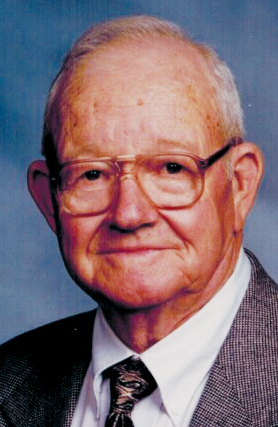
John Thomas Rogers, 96 of the Pinhook Community in Robbinsville, N.C., passed away early Sunday, Aug. 1, 2021, at Graham Healthcare and Rehabilitation.
A native of Graham County, he was the son of the late J. Arthur and Mary Holloway Rogers, and the youngest of nine children. In addition to his parents and siblings, he was preceded in death by his granddaughter, Tonya Lewis Curtis; and great-grandson, Kyle Garver on Aug. 10, 2016.
In April of 1943, after having just turned 18 in February, John was drafted into the U.S. Army, to serve his country in World War II. After surviving boot camp, in which he almost died from the mumps, he was shipped across the Atlantic to England. He recalled that the trip over was so treacherous on a smaller ship – avoiding German submarines – that he thought that he would die from sea sickness and vowed that if he survived the war, that he would remain in Europe, rather than suffer another ocean crossing.
John arrived in Europe April 4, 1944 and was assigned to the 158th Engineer Combat Battalion, encamped in Stroud, England. On June 6, 1944 he was deployed to the Beaches of Normandy, France in the D-Day campaign. He landed on Utah Beach and thus began his introduction to combat. He would continue throughout the campaigns of Northern France, Rhineland, Ardennes and Central Europe.
During December 1944 – the coldest winter on history in Belgium – his unit was part of The Battle of the Bulge. On Dec. 14, 1944, they were assigned to protect VIII Corps headquarters at Bastogne until the 101st Airborne Division arrived.
“Engineers constructed and manned a line of roadblocks, hasty minefields and dug-in positions. They stretched chains of antitank mines across the roads and covered these obstacles with rifles, machine guns, and bazookas. Elements of an armored division were forced back leaving the 158th Engineer Combat Battalion and a company of the 35th Engineer Combat Battalion as the only force in front of Bastogne. By the afternoon of December 19th, the engineers had held the line long enough for the 101st to move up and relieve them.”
It was during this time that John got trapped behind enemy lines and had to walk through frozen streams to evade capture. As a result, he suffered frost bite on his feet – which he never reported, as the soldiers had been threatened with disciplinary action if anyone got their feet frostbit.
By the time the war was over, he decided that he would return home to the mountains of western North Carolina. He was fortunate that the cruise home was on a luxury ocean liner, arriving back in the United States on Oct. 24, 1945. He received the Eamet Campaign Medal with five Bronze Service Stars and a Good Conduct Medal.
Although requested to speak about his experiences during the war, John always refused, saying “Unless you’ve been through it, you just don’t understand.” He would share some stories about his time there, but never about combat or the atrocities that he witnessed. John had always been a prankster – having inherited that skill from his father – and earned himself the nickname of “Rumormonger” amongst his fellow soldiers. He was known for filling empty bottles of cognac with vinegar and spinning elaborate yarns, one of which almost got him court martialed – or so he feared, had it not been that his superior officer had to suppress a chuckle when he heard his explanation.
In June 2002, he returned to Normandy and on the 58th anniversary of D-Day, he walked along the beaches once more, and in the graveyard among the rows-upon-rows of American soldiers lost that fateful day. He seemed to be searching for something familiar, finally having found it in a local soup served in a Belgian café that tasted like the soup served to him by a Belgian family who hid him and some other soldiers from the Germans;
and in the curvy road down to a small village named La Roche-en-Ardenne, where he remembered a bombed-out church resting on a hill above the village.
After returning to the United States, John spent his life working primarily as a millwright in the construction of powerhouses for hydroelectric projects. He was at one time considered one of the leading authorities in the installation of turbines. After retiring from Duke Power, John spent his retirement doing volunteer work and taking long walks along mountain paths with his dog, Peanut.
John was an active member of Robbinsville Masonic Lodge No. 672, Robbinsville Order of the Eastern Star Chapter No. 224 and Robbinsville Shrine Club.
He is survived by his wife of almost 58 years, Dorothy Waldroup Rogers; sons, Mitch Rogers and James (Porky) Lewis, of Robbinsville, N.C., Steve Rogers of Franklin, N.C. and Lamar Lewis, of Pumpkin Center, N.C.; and daughter, Robin Rogers of Robbinsville, N.C.; in addition to eight grandchildren and 17 great-grandchildren.
He is also survived by his “Baby Puppy Dog” Penny, whom he loved and spent his last years just holding in his lap.
Graveside services were held at 11 a.m. Thursday, Aug. 5, 2021 at Carver Cemetery. The Revs. G.D. Phillips and Marty Maxwell officiated. Full Military Rites were conducted by Eller Rogers American Legion Post 192, Carringer Webster VWF Post 8635 and the N.C. National Guard Honor Guard. Masonic Rites were conducted by Robbinsville Lodge No. 672.
Serving as pallbearers were Keith Rogers, Bryan Farley, Dwight Millsaps, Jeffrey Crisp, Terry Slaughter, Jerry Rogers, Ronnie Rogers, Mark Rogers, Bryan Waldroup, and honorary pallbearers Paul Crisp and Bobby Rogers.
The family requests that in lieu of flowers, donations be made in John’s memory to:
Shriners Hospital for Children
c/o Robbinsville Shrine Club
P.O. Box 2404
Robbinsville, NC 28771.
Townson-Smith Funeral Home was honored to serve the Rogers family.
An online register is available at townson-smithfuneralhome.com.
